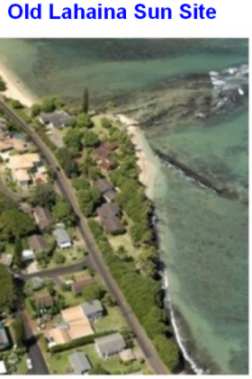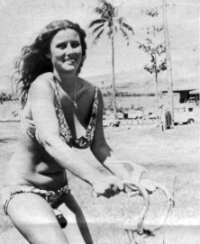National Geographic Magazine:
Maui: The Old And The New
BY KINDLY, OLD, BELOVED DON GRAYDON
NATIONAL GEOGRAPHIC PAGE BUILT BY CANTANKEROUS,
YOUNG-AT-HEART BUCK QUAYLE
The title of a feature article in this month's National Geographic magazine is : "Maui, Where Old Hawaii Still Lives".
A more appropriate title would have been: "Maui, Where Old Hawaii Used To Live".
But then, this is the Nat.Geo.
I assume the title was written even before the reporter, Kenneth Weaver, set off to see Maui for himself.
The magazine's title might be appropriate for the Hana area of Maui.
But for the rest of Maui?
Let's mention some of the things going on in Maui today.
The County is spending millions for new roads, civic centers, sewage treatment facilities.
A large chunk of Wailuku is preparing for urban renewal.
The big Kahului housing subdivision is growing, increment by increment.
Massive tourist developments are underway at Kaanapali, Honolua and Wailea.
The sugar industry is in a tight bind from rising costs, foreign competition, and reguirements to cut down on air and waste pollution.
Does this sound like the Old Hawaii?
"In much of Hawaii," Weaver writes in the article, "the onrushing present is relentlessly obliterating the past. The taro patch and grass shack give way to the subdivision, the freeway, the high rise."
Doesn't Weaver realize this has already happened?
"But on Maui," Weaver states, "the past is fighting back."
Well, maybe. The Lahaina Restoration Foundation is trying to bring back some of the monuments and skills of the past.
But in real Maui, people are busy fighting the traffic on Front Street and Honoapiilani Highway and Kaahumanu Highway, paying taxes, following the latest clothing styles, watching "Laugh-In", paying the phone bill, sending their kids to college, watching the Super Bowl, and generally doing what everybody else is doing on the mainland.
The only thing missing in the article was a photograph of Mrs. Grosvenor of the Geographic with her shawl wrapped protectively around the shoulders of one of the native girls. Such a photo was a mainstay of earlier Geographic forays into Africa and other areas of the world, and I missed it this time around.
However, Weaver did manage to rescue the Geographic image with a description of Dr. Milton Howell of Hana as "beloved". In the Geographic, doctors and missionaries always are "beloved", and usually are "kindly" and "old" to boot.
As usual, the Geographic color photos are superb. Particularly striking are photos of Haleakala Crater, a west Maui surfer, a Makawao couple in their cabbage field, a fisherman on Maui's east coast, and the Lahaina small boat harbor.
Lahaina received tremendous play in the article, with interesting descriptions of the Baldwin House, the Carthaginian, Lahainaluna High School, the Lahaina Jodo Mission and other attractions.
Quoted in the article are some of west Maui's leading citizens, including wood craver Sam Kaai, Tim Mitchell of the Restoration Foundation, Skipper Don Bell of the Carthaginian and Pete Sanborn of Amfac Properties.
Weaver also takes his readers on a hike through Haleakala Crater and on a visit to Hana. For some reason, however, he skips any mention of Iao Valley, which certainly must be included among the major visitor attractions on the island.
But Wait-There's More!!!
You say you'd like to write for the National Geographic Magazine?
Then, take this simple test. Circle one of the three possible answers in each of the multiple choice sentences below. Then check your score, and see if you qualify as a National Geographic writer.
(All examples of picturesque prose are taken from the article, "Maui, Where Old Hawaii Still Lives", in the April issue of National Geographic.)
1. Palm trees A. shake B. rattle C. rustle.
2. A Pacific sunset is A. a spectacle B. a disappointment C. a mind-blower.
3. Lahaina is A. dirty but nice B. charming but sleepy C. old but majestic.
4. Across the sky, the rainbow A. arches B. shimmers C. glowers.
5. Old volcanos A. dance B. play C. slumber.
6. Ravines are A. lazy B. majestic C. precipitious.
7. White sails are seen against A. playful whales B. majestic mountains of foam C. cloud-topped slopes.
8. Rain forrests are A. lush B. wet C. fertile.
9. Waterfalls A. plunge B. tower C. fall.
10. The valleys are dappled with A. clouds B. cows C. trees.
11. The ocean surf A. curls B. leaps C. sings.
12. Mist and clouds A. conspire B. play C. fight.
13. Ravines are shrouded in A. green B. plastic C. silence.
14. Sugar cane is seen in A. colorful collections B. bright stretches C. verdant pastures
Ten or more corretc answers qualify you as a potential Geographic prose artist. If you get seven to ten right, keep trying. Less than seven qualifies you as a Geographic reader, but not a writer.
ANSWERS:
1-C / 2-A / 3-B / 4-A / 5-C / 6-C / 7-C / 8-A / 9-B / 10-A / 11-A / 12-B / 13-A / 14-B
To Go To Promotion-From National Geographic-Click Here
To Go To Week On Maui-Click Here
To Go To Maui Libidinous Solicitations-Click Here
To Go To Aloha Lawbreakers-Click Here
Maui Lahaina Sun

Buck Quayle at the Maui Lahaina Sun bureau circa 1970
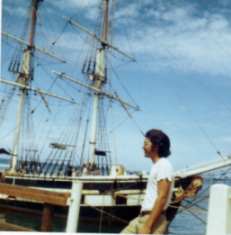
Reporter/Photographer Buck Quayle in 1971 in Maui with the Cartagenian in the background
Buck Quayle, 2011
Hawaii
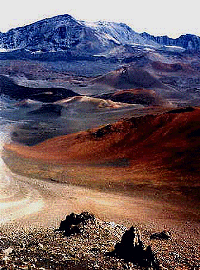
Another Day At The Office Haleakala National Park
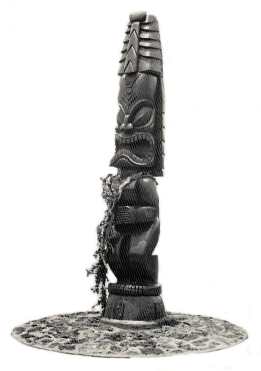
Tiki
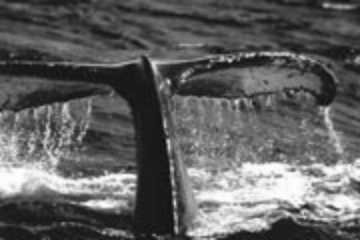
Whale tail
